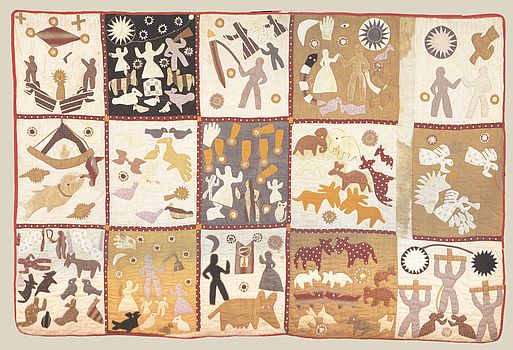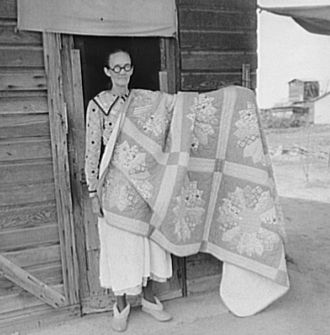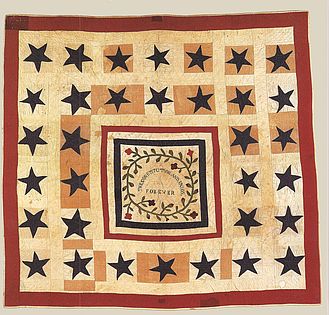Analyzing Quilts
Like the Prentiss family, other families and museums proudly preserve and display their quilts as evidence of connection to war. While mid-nineteenth century America saw great technological and mechanical strides, traditional homespun and fine needlework occurred apace in homes across the country. Quilts proliferated for utilitarian reasons (although factories began to provide wool blankets at nominal costs), as well as for means to express design, creativity, and memory. Beyond mere utility, according to historian Laurel Thatcher Ulrich, a nostalgic curiosity and value in homespun aroused interest in traditional forms and the messages attached to them.
Nineteenth-century Americans understood that objects tell stories. They wrote their stories in speeches, memoirs, and poems, and on scraps of paper that they pinned, pasted, or sewed to the things they saved. These were stories about patriotism, family pride, and household industry.
—Laurel Thatcher Ulrich 9
Ulrich describes how quilts and other items of material culture are imbedded with the rich texture of local history, a valuable field of cultural production and presentation.10 Quilts, according to Peter S. Hawkins, represent Americana at its most pure. “As our quintessential folk art, the patchwork quilt is linked to nineteenth-century sewing bees and a nostalgia for a past sense of community. Perhaps the only thing like it in our national mythology is that other needlework of fabric, color, and pattern that Betsy Ross turned into America’s most revered symbol, the American flag.”11 Thus memory intertwines with history to illustrate a unique window of culture blending utility and sentiment.
Traditionally a female craft, quilt-making reveals much about gender roles and women’s participation in society and culture. Ann Douglas theorizes that the nineteenth-century saw the “feminization of American culture,” a surprising reaction and contradiction to the violence of war.12 Women sentimentalized the world around them, thus feeling a sense of participation and control. Quilting allowed them to literally stitch together scraps into meaningful and useful pieces. While nineteenth-century American cultural, economic, and political gender roles generally placed women at the home front and men in combat and military leadership, women actively participated in many important war activities. Quilts situate women’s experience with the raw violence of war and the destruction on home and family. Winter defines observers of war as having growing significance. They are, he writes, “storytellers of a special kind. They are individuals with a terrible tale to tell, people whose very lives are defined by that story.”13 Quilts illustrate the woman’s witness of the war in unique, tangible ways. Quilt historians Pat Ferrero, Elaine Hedges, and Julie Silber describe how quilts act as conduits to these memories. “Through their quilts women became, in fact, not only witnesses to but active agents in important historical change.”14
Many quilt makers consciously chose specific items to depict in pictorial quilts. Elsley analyzes quilts as texts. The quilt is not just a bed cover, but it can be a political manifesto: “It speaks its maker’s desires and beliefs, hopes and fears” through its images, colors, patterns, and pieces.15 As well, families consciously chose which stories to tell with their quilts as they were handed down from generation to generation, evident in the current existence of stories. Both quilt makers and quilt keepers act as agents in determining which memories are preserved. According to historian Michael Kammen, people are highly selective about their perceptions of the past. Selective versions of the past mobilize to serve particular partisan purposes in the present. Moreover, he writes, “Wars have played a fundamental role in stimulating, defining, justifying, periodizing, and eventually filtering American memories and traditions.”16 Thus quilts commemorating war illustrate deliberate beliefs and attempts to memorialize national loyalties for families and future generations.
The preservation of these quilts reveals a nostalgic turn to the past. Quilt historians Cheryl B. Torsney and Judy Elsley have traced the popular interest in quilts. “Quilts in the twentieth century have not become dead cultural artifacts of the past. Rather, as political as well as aesthetic statements, they have taken on lives as texts to be positioned, read, and restitched (or reinscribed).”17 Quilts passed down through the generations of families and preserved in museums and historical societies.
Quilts have served as “modes of collective remembrance,” as described by historian Jay Winter.18 Fragments of fabric with special designs trigger specific memories and link individuals to historical events. Daryl M. Hafter writes about quilts as windows into customs, human relationships, and individual awareness accompanying events from the past.19 For example, wedding and baby quilts explicitly celebrate relationships and family events. Historian John Bodnar writes about the power of vernacular culture—the memory of ordinary people with diverse experiences to participate in a larger whole. Modes of vernacular culture such as quilts can spark discussion about contradiction between loyalty to family and loyalty to nation, revealing the consciousness of people involved in national events such as war.20

Quilts commemorating war and personal experience with war, both in direct combat and at the home front, reveal these contradictions between nation and family, as well as illustrate individual experience with war and ordinary reaction and memory of that experience. Commemorative war quilts, then, witness gendered, social, political, and cultural memories of war.


